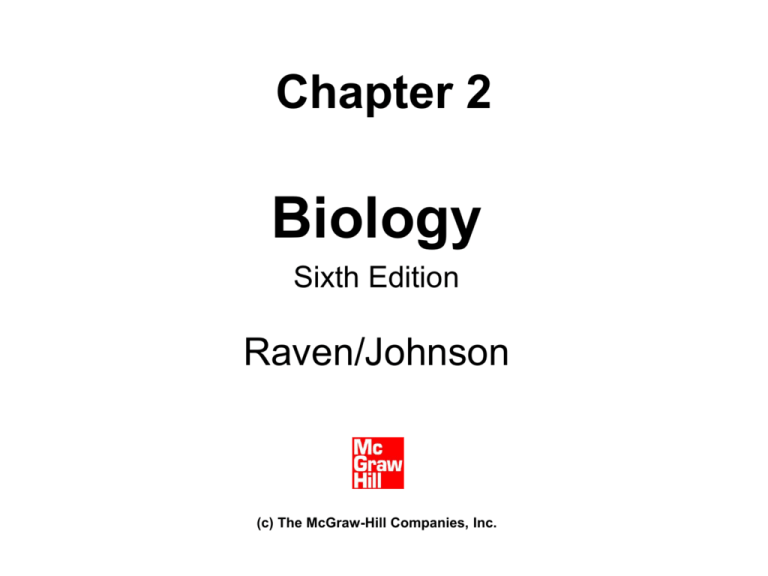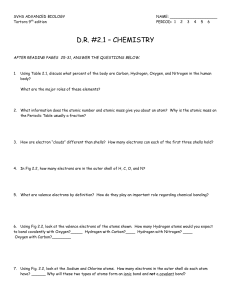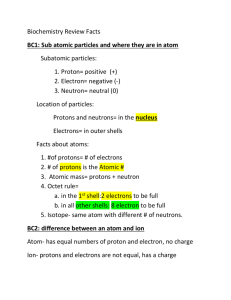ch02
advertisement

Chapter 2 Biology Sixth Edition Raven/Johnson (c) The McGraw-Hill Companies, Inc. Matter is anything that takes up space and has weight. All matter, living or nonliving, is made up of elements Elements contain atoms, the smallest unit of matter that can enter chemical reactions. Atoms have a central nucleus made up of protons (+) and neutrons (o), and shells around the nucleus in which electrons (-) orbit. Fig 2.2 The atomic number = number of protons (# of protons determines the element). • protons bear a positive electrical charge The atomic weight = number of protons plus number of neutrons. • neutrons bear no electrical charge • electrons bear a negative electrical charge An electrically neutral atom means: number of protons = number of electrons Atoms have an atomic symbol, atomic number, and atomic mass. Some atoms differ in their number of neutrons and are called isotopes. Carbon has 3 isotopes: • Carbon 12 (most abundant) • Carbon 13 • Carbon 14 (radioactive - unstable) Fig 2.3 Which has more mass? Review of an Atom 3 10 2 in inner shell 8 e- in outer shell 10 e- TOTAL 10 neutrons 10 protons 20 atomic mass units 4 1 e- 9 5 Element = Ne (Neon) 8 2 6 # of protons determine element 7 Atomic number 10 Ne Atomic mass 20 Chemical Behavior of Atoms Because an atom’s electrons are relatively far from the nucleus, the nuclei of two atoms never come close enough in nature to interact with each other. Therefore, an atoms electrons determine its chemical behavior. Electron Orbital vs. Energy Level • Electron Orbital – The area around a nucleus that an electron is most likely to be found. • Electron Energy Level – The potential energy of an electron is directly related to the distance between an electron and the nucleus. – Energy – the ability to do work Fig 2.4 Only 2 electrons per orbital Fig 2.5 K only has ‘s’ orbital (1s) L and M has ‘s’ and ‘p’ orbitals (L: 2s and 2p; M: 3s and 3p) Fig 2.7 Elements are arranged in a periodic table by atomic number and # electrons in outer shell: 1 Electron in Outer Shell Outer Shell Full Distribution of the Elements Fig 2.8 Important Atom Characteristics • Electrons in the outermost energy level are called valence electrons. – These are the electrons that determine the atoms chemistry • Octet rule (rule of eight) – For most atoms important to life, the outer energy level can contain no more than eight electrons. Fig 2.6 Oxidation – The loss of an electron (atom becomes electrically positive) Reduction – The gain of an electron (atom becomes electrically negative) Chemical Bonds Build Molecules • Bonds between atoms can either be ionic, covalent, or hydrogen. • Ionic and covalent bonds are the result of interactions among electrons. • Hydrogen bonds are attractions between weakly positive and weakly negatively charged particles. Fig 2.9 In ionic bonding, atoms either give up or accept electrons, resulting in ions (electrically charged atoms/non-neutral). Ions with opposite charges (- or +) are attracted to each other and form an ionic bond. (Opposite charges attract, + is attracted to -, - is attracted to +). Fig 2.10 In covalent reactions, atoms share electrons, resulting in covalent bonds. Covalent Bonds -build stable molecules 7 e- in outer shells 2 shared e- to complete both outer shells Aside from single covalent bonds, double, or triple covalent bonds can form. Which is stronger? Why is a molecule formed by covalent bonds stable? • It has not net charge • The octet rule is satisfied • It has no free electrons Fig 2.12 Fig 2.13 Important Properties of Water • • • • • Cohesion (liquid) / Adhesion (polarity) High Specific Heat (maintain temperature) High Heat of Vaporization (cools body) Lower Density of Ice (water bodies) High Polarity / Water as a Solvent Fig 2.14 Fig 2.15 Fig 2.16 Fig 2.17 Water Ionizes • Water dissociates and releases hydrogen ions (H+) and hydroxide ions (OH-). • Concentrations of hydrogen ions or hydroxide ions can be represented using the pH scale. moles/liter 1 x 10 –6 [H+] = pH 6 1 x 10 –7 [H+] = pH 7 1 x 10 –8 [H+] = pH 8 *A mole is the atomic weight of a molecule weighed out in grams. Atomic weight of H+ is one. pH Concentration of H+ pH 0 = 1x10-0 pH 1 = 1x10-1 pH 2 = 1x10-2 pH 3 = 1x10-3 pH 4 = 1x10-4 pH 5 = 1x10-5 pH 6 = 1x10-6 pH 7 = 1x10-7 pH 8 = 1x10-8 pH 9 = 1x10-9 pH 10 = 1x10-10 pH 11= 1x10-11 pH 12 = 1x10-12 pH 13 = 1x10-13 pH 14 = 1x10-14 1 0.1 0.01 0.001 0.0001 0.00001 0.000001 0.0000001 0.00000001 0.000000001 0.0000000001 0.00000000001 0.000000000001 0.0000000000001 0.00000000000001 • Acids are molecules that release hydrogen ions in solution (usually water). HCl H+ + Cl•Bases are molecules that either take up hydrogen ions or give off hydroxide ions in solution. NaOH Na+ + OHHydroxide ion Fig 2.18 • Buffers are substances that help to resist change in pH. Buffers will take-up/remove excess hydrogen ions (H+) or hydroxide (OH-) ions. When hydrogen ions are added to solution the following reaction occurs: H+ + HCO3¯ H2CO3 When hydroxide ions are added to solution the following reaction occurs: OH ¯ + H2CO3 HCO3¯ + H2O Fig 2.20 Fig 2.19






